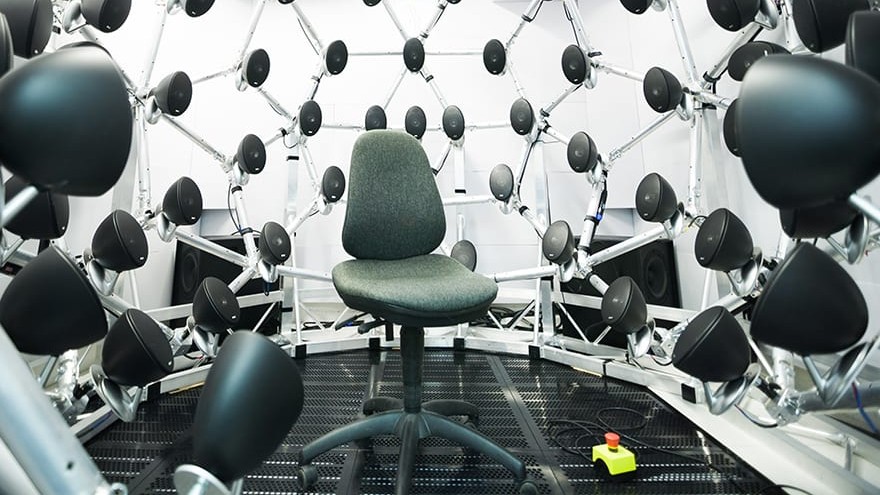Scientists in Canada have built a speaker array that can mimic a 3D soundscape with such fidelity that, to the human ear, it sounds exactly like the real thing.
The 11-foot (3.4 meters) AudioDome speaker system, set up in a sealed chamber in Ontario, leverages advanced audio-rendering techniques to create rich virtual sound fields that simulate the precise locations of sounds as they were recorded — sonically transporting users anywhere in the world.
In new research, scientists tested the speaker system on people to evaluate its accuracy. The results showed that the AudioDome could simulate soundscapes with a level of detail that was beyond the limits of human auditory perception. The researchers published their findings April 15 in The Journal of the Acoustical Society of America.
The results demonstrated that ambisonics technology could be used for more in-depth research into how the human brain processes sounds, the researchers wrote in the paper.
The dome gives researchers the ability to “maintain tight experimental control while also studying human auditory spatial perception in the type of complex, dynamic, three-dimensional soundscapes that the auditory system evolved to handle,” study lead author Nima Zargarnezhad, a graduate student in neuroscience and music cognition at Western University, Ontario, said in a statement.
A new frontier for simulating sounds in 3D
Surround-sound technology has been around for a while, often employing other forms of sound reproduction such as single-channel (SC) presentation or vector-based amplitude panning (VBAP) to provide listeners with an immersive listening experience.
In a single-channel surround sound system the presented sound source is constrained by the physical location of each speaker in the array, whereas VBAP relies on manipulating the gain across a trio of speakers in the array, creating a virtual source somewhere between them to approximate the original sound’s location.
But neither of these systems can create an accurate virtual soundscape over as broad an area as ambisonic panning, according to the study.
Related: Self-bending beams can deliver sound waves only to your ear in a crowd
Ambisonic panning is a sound-reproduction technique that decomposes a 3D soundscape into a series of mathematical functions that describe each sound’s directionality, pressure and velocity.
Theoretically, ambisonic panning also has higher spatial resolution than both SC or VBAP, the researchers wrote — but it has its limitations. Lower-order ambisonic panning systems (those with fewer channels) were found to render sound sources in a way that is “blurry” or diffused.
The AudioDome gave the researchers the chance to test whether a higher order ambisonic panning system could achieve sufficient spatial resolution to be suitable for experiments that study human hearing and perception.
“We already knew that some reconstruction errors were theoretically predicted and confirmed with simulations, but we did not know how and to what extent they would affect human perception of sound location and identity,” Zargarnezhad said.
Made up of four dual–channel subwoofers and 91 loudspeakers arranged in a dome, the structure is positioned in a sound dampening, echo-free chamber to provide maximum control over the acoustic environment.
The AudioDome’s speaker array is a ninth-order ambisonic panning system (meaning that it uses 100 sound channels in the system) which the researchers found was capable of reproducing the “identity and location of many common sounds, including speech, at a spatial resolution that is at the level of human spatial acuity, if not better.”
This means the AudioDome was “sufficient to ensure the reproduced soundscapes are accurately simulating the real world,” the researchers concluded.
The study highlights one weakness in ambisonic panning, however. For sounds with energy frequencies above 4 kHz, such as the human vocal range, the localization cues became distorted — meaning the information that helps the brain determine the location sound is coming from seemed incorrect to listeners.
The result was that speech, although reproduced “accurately,” was somewhat degraded and instead sounded as if it was being heard over a phone line. As such, the paper recommended using SC reproduction for “naturalistic studies of speech.”
Nonetheless, the researchers wrote that the AudioDome offers a promising advancement for research into how our brains process sound and “lays the groundwork for future experiments on naturalistic human auditory perception.”
